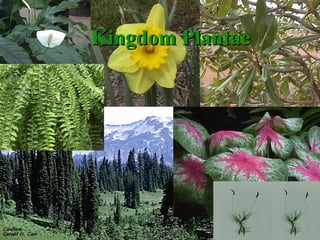Signaler
Partager

Recommandé
This slideshow is used to teach botany to Master Gardeners in Beauregard Parish, LA. Mr. Jeff McMillian, Advanced Master Gardener, teaches this class and developed this PPT in collaboration with another PPT cited in this presentation.2017 Beauregard Parish Master Gardener Class: Botany by Jeff McMillian, Adv. ...

2017 Beauregard Parish Master Gardener Class: Botany by Jeff McMillian, Adv. ...LSU Agcenter, LA Master Beekeeper Advisory Group
Recommandé
This slideshow is used to teach botany to Master Gardeners in Beauregard Parish, LA. Mr. Jeff McMillian, Advanced Master Gardener, teaches this class and developed this PPT in collaboration with another PPT cited in this presentation.2017 Beauregard Parish Master Gardener Class: Botany by Jeff McMillian, Adv. ...

2017 Beauregard Parish Master Gardener Class: Botany by Jeff McMillian, Adv. ...LSU Agcenter, LA Master Beekeeper Advisory Group
Contenu connexe
Tendances
Tendances (20)
Kingdom Plantae presented by Vrushali Gharat to Mr. Kailash vilegave

Kingdom Plantae presented by Vrushali Gharat to Mr. Kailash vilegave
diversity in living organisms-kingdom plantae-pteridophyta

diversity in living organisms-kingdom plantae-pteridophyta
Similarities and dissimilarities of algae and plants

Similarities and dissimilarities of algae and plants
En vedette
En vedette (19)
A Botanical Introduction to The Biodiversity Heritage Library

A Botanical Introduction to The Biodiversity Heritage Library
Similaire à Plant biology
Similaire à Plant biology (20)
Kingdom plantae by Sayali Diwan presented to Mr. Kailash Vilegave ( Navdhare ...

Kingdom plantae by Sayali Diwan presented to Mr. Kailash Vilegave ( Navdhare ...
Plant biology
- 2. What Is a Plant? Multicellulareukaryotes that are photosynthetic autotrophs Cell walls made of cellulose Store surplus carbohydrates as starch Mostly terrestrial
- 3. Obstacles Plants Overcome Absorb Minerals Conserve Water – Cuticle – Stomata – Guard Cells Reproduce on Land
- 4. A Vascular System Enables Plants to Thrive on Land Most plants need a “plumbing” system to transport water, minerals and nutrients. This system is known as the VASCULAR SYSTEM.
- 5. Divisions of Living Plants Are Divided into Nonvascular and Vascular There are 3 divisions of nonvascular plants – Hepatophyta – the Liverworts • Simplest of plants (gametophytes are dominate • Flat leafy body lacking cuticle, stomata, roots, stems or leaves – Anthocerophyta – the Hornworts • Dominate gametophyte and have stomata – Bryophyta – the mosses • Small, most have simple vascular tissue • Sporophyte with slender stalk and spore capsule • “leafy” green gametophyte that lacks roots, stems and leaves
- 6. Alternation Of Generations Occurs in life cycle of all plants One generation is a multicellular haploid condition and the next is a multicellular diploid condition
- 7. Gametes Archegonia – Produce eggs Antheridia – Produce sperm When water is available, sperm swim to the eggs
- 9. Features of Vascular Plants Dominate sporophyte Specialized conducting cells Distinctive body form – Meristem • Shoots • Roots
- 11. Life Cycle of a Fern
- 12. Evolution of the Seed There are 5 phyla of living seed plants. Four of these phyla are collectively known as GYMNOSPERM. The other phyla is ANGIOSPERMS.
- 13. Seed plants produce two kinds of gametophytes. – Microgametophyte – produce male – Megagametophyte – produce female – These develop from a megaspore within the ovule. A pollen grain consists of only a few haploid cells surrounded by a thick protective wall.
